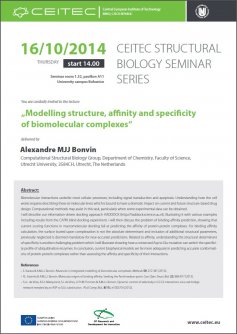Abstract:
Biomolecular interactions underlie most cellular processes, including signal transduction and apoptosis. Understanding how the cell works requires describing these at molecular level, which is bound to have a dramatic impact on current and future structure-based drug design. Computational methods may assist in this task, particularly when some experimental data can be obtained.
I will describe our information-driven docking approach HADDOCK, illustrating it with various examples including results from the CAPRI blind docking experiment. I will then discuss the problem of binding affinity prediction, showing that current scoring functions in macromolecular docking fail at predicting the affinity of protein-protein complexes. For binding affinity calculation, the surface buried upon complexation is not the absolute determinant and inclusion of additional structural parameters, previously neglected is deemed mandatory for near-accurate predictions. Related to affinity, understanding the structural determinant of specificity is another challenging problem which I will illustrate showing how a conserved Asp to Glu mutation can switch the specificity profile of ubiquitination enzymes. In conclusion, current biophysical models are far more adequate in predicting accurate conformations of protein-protein complexes rather than assessing the affinity and specificity of their interactions.
References:
- E. Karaca & A.M.J.J. Bonvin. Advances in integrated modelling of biomolecular complexes. Methods 59, 372-381 (2013).
- P.L. Kastritis & A.M.J.J. Bonvin. Molecular origins of binding affinity: Seeking the Archimedean point. Curr. Opin. Struct. Biol. 23, 868-877 (2013).
- S.J.L. de Vries, A.S.J. Melquiond, S.J. de Vries, H.Th.M Timmers & A.M.J.J. Bonvin. Dynamic control of selectivity in E2-E3 interactions via a salt-bridge network revealed by an ASP to GLU substitution. PLoS Comp. Biol., 8(11), e1002754 (2012).








